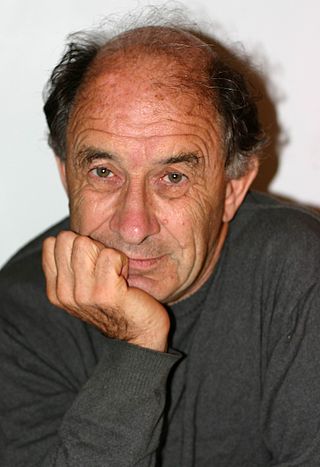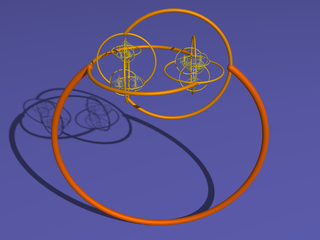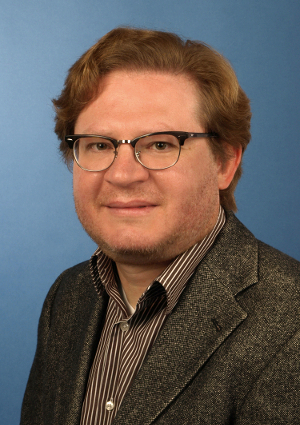
Sergei Tabachnikov, also spelled Serge, (born in 1956) is an American mathematician who works in geometry and dynamical systems. He is currently a Professor of Mathematics at Pennsylvania State University.

Sergei Tabachnikov, also spelled Serge, (born in 1956) is an American mathematician who works in geometry and dynamical systems. He is currently a Professor of Mathematics at Pennsylvania State University.
He earned his Ph.D. from Moscow State University in 1987 under the supervision of Dmitry Fuchs and Anatoly Fomenko. [1] He has been living and working in the USA since 1990.
From 2013 to 2015 Tabachnikov served as Deputy Director of the Institute for Computational and Experimental Research in Mathematics (ICERM) in Providence, Rhode Island. [2] He is now Emeritus Deputy Director of ICERM. [3]
He is a fellow of the American Mathematical Society. [4] He has served as Editor-in-Chief of the journal Experimental Mathematics , and is currently serving as Editor-in-Chief of the Arnold Mathematical Journal and as co-Editor-in-Chief of the Mathematical Intelligencer . [5] [6] [7]
A paper on the variability hypothesis by Theodore Hill and Tabachnikov was accepted and retracted by The Mathematical Intelligencer and later The New York Journal of Mathematics (NYJM). There was some controversy over the mathematical model, the peer-review process, and the lack of an official retraction notice from the NYJM. [8]

Vladimir Igorevich Arnold was a Soviet and Russian mathematician. He is best known for the Kolmogorov–Arnold–Moser theorem regarding the stability of integrable systems, and contributed to several areas, including geometrical theory of dynamical systems theory, algebra, catastrophe theory, topology, real algebraic geometry, symplectic geometry, symplectic topology, differential equations, classical mechanics, differential geometric approach to hydrodynamics, geometric analysis and singularity theory, including posing the ADE classification problem.
Hopf–Rinow theorem is a set of statements about the geodesic completeness of Riemannian manifolds. It is named after Heinz Hopf and his student Willi Rinow, who published it in 1931. Stefan Cohn-Vossen extended part of the Hopf–Rinow theorem to the context of certain types of metric spaces.

The Alexander horned sphere is a pathological object in topology discovered by J. W. Alexander. It is a particular topological embedding of a two-dimensional sphere in three-dimensional space. Together with its inside, it is a topological 3-ball, the Alexander horned ball, and so is simply connected; i.e., every loop can be shrunk to a point while staying inside. However, the exterior is not simply connected, unlike the exterior of the usual round sphere.
Richard Evan Schwartz is an American mathematician notable for his contributions to geometric group theory and to an area of mathematics known as billiards. Geometric group theory is a relatively new area of mathematics beginning around the late 1980s which explores finitely generated groups, and seeks connections between their algebraic properties and the geometric spaces on which these groups act. He has worked on what mathematicians refer to as billiards, which are dynamical systems based on a convex shape in a plane. He has explored geometric iterations involving polygons, and he has been credited for developing the mathematical concept known as the pentagram map. In addition, he is author of a mathematics picture book for young children. In 2018 he is a professor of mathematics at Brown University.

Yuri Ivanovich Manin was a Russian mathematician, known for work in algebraic geometry and diophantine geometry, and many expository works ranging from mathematical logic to theoretical physics.
In mathematics, an exotic is a differentiable manifold that is homeomorphic but not diffeomorphic to the Euclidean space The first examples were found in 1982 by Michael Freedman and others, by using the contrast between Freedman's theorems about topological 4-manifolds, and Simon Donaldson's theorems about smooth 4-manifolds. There is a continuum of non-diffeomorphic differentiable structures of as was shown first by Clifford Taubes.

Victor Matveevich Buchstaber is a Soviet and Russian mathematician known for his work on algebraic topology, homotopy theory, and mathematical physics.
John Willard Morgan is an American mathematician known for his contributions to topology and geometry. He is a Professor Emeritus at Columbia University and a member of the Simons Center for Geometry and Physics at Stony Brook University.

In geometry, a flexible polyhedron is a polyhedral surface without any boundary edges, whose shape can be continuously changed while keeping the shapes of all of its faces unchanged. The Cauchy rigidity theorem shows that in dimension 3 such a polyhedron cannot be convex.
In topology, an Akbulut cork is a structure that is frequently used to show that in 4-dimensions, the smooth h-cobordism theorem fails. It was named after Turkish mathematician Selman Akbulut.
Mikhail Mikhailovich Postnikov was a Soviet mathematician, known for his work in algebraic and differential topology.

Yakov Matveevich Eliashberg is an American mathematician who was born in Leningrad, USSR.

Matthias Kreck is a German mathematician who works in the areas of Algebraic Topology and Differential topology. From 1994 to 2002 he was director of the Oberwolfach Research Institute for Mathematics and from October 2006 to September 2011 he was the director of the Hausdorff Center for Mathematics at the University of Bonn, where he is currently a professor.
In Riemannian geometry, a field of mathematics, Preissmann's theorem is a statement that restricts the possible topology of a negatively curved compact Riemannian manifold. It is named for Alexandre Preissmann, who published a proof in 1943.

Ilka Agricola is a German mathematician who deals with differential geometry and its applications in mathematical physics. She is dean of mathematics and computer science at the University of Marburg, where she has also been responsible for making public the university's collection of mathematical models.

In geometry, Steffen's polyhedron is a flexible polyhedron discovered by and named after Klaus Steffen. It is based on the Bricard octahedron, but unlike the Bricard octahedron its surface does not cross itself. With nine vertices, 21 edges, and 14 triangular faces, it is the simplest possible non-crossing flexible polyhedron. Its faces can be decomposed into three subsets: two six-triangle-patches from a Bricard octahedron, and two more triangles that link these patches together.

Dmitry Feichtner-Kozlov is a Russian-German mathematician.

Dmitry Borisovich Fuchs is a Russian-American mathematician, specializing in the representation theory of infinite-dimensional Lie groups and in topology.

In geometry, the tennis ball theorem states that any smooth curve on the surface of a sphere that divides the sphere into two equal-area subsets without touching or crossing itself must have at least four inflection points, points at which the curve does not consistently bend to only one side of its tangent line. The tennis ball theorem was first published under this name by Vladimir Arnold in 1994, and is often attributed to Arnold, but a closely related result appears earlier in a 1968 paper by Beniamino Segre, and the tennis ball theorem itself is a special case of a theorem in a 1977 paper by Joel L. Weiner. The name of the theorem comes from the standard shape of a tennis ball, whose seam forms a curve that meets the conditions of the theorem; the same kind of curve is also used for the seams on baseballs.
Yongbin Ruan is a Chinese mathematician, specializing in algebraic geometry, differential geometry, and symplectic geometry with applications to string theory.